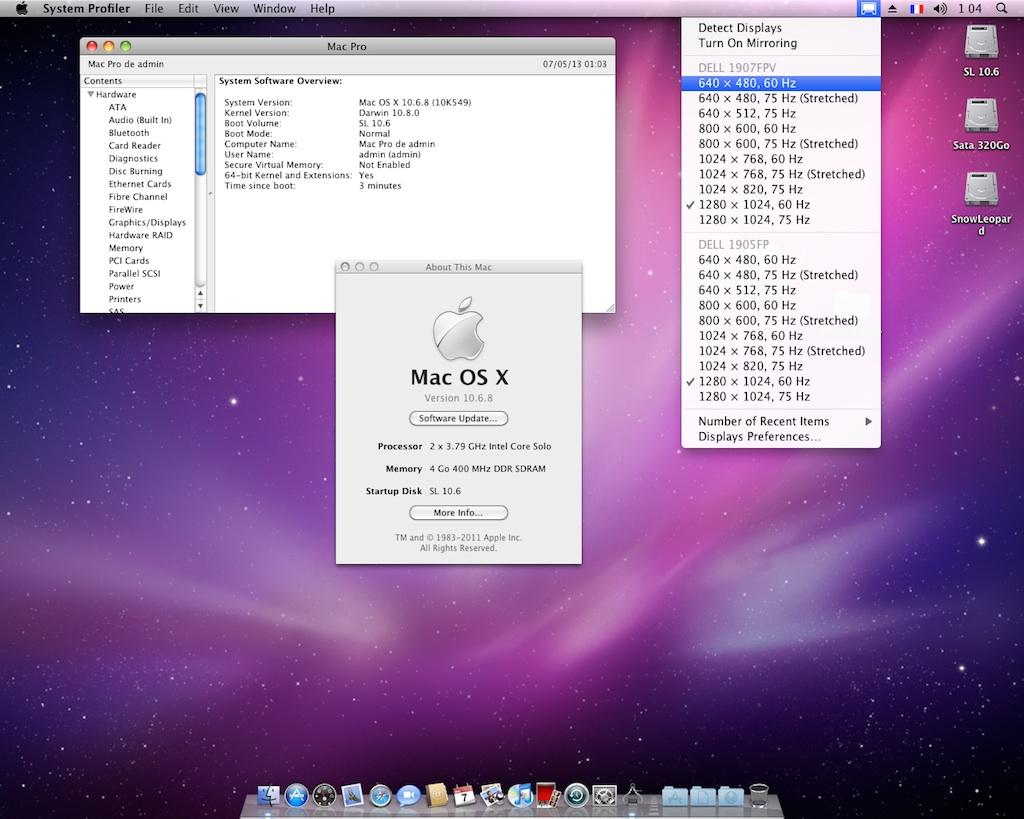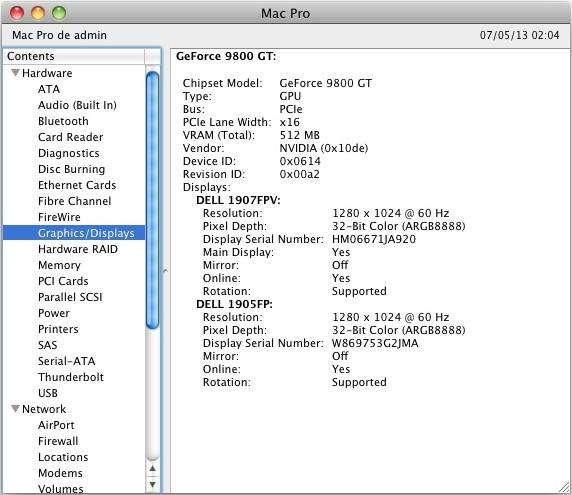-
Posts
10068 -
Joined
-
Last visited
-
Days Won
569
Content Type
Profiles
Articles, News and Tips
Forums
Everything posted by Hervé
-
Just follow the guide step by step and it'll get you there.
-
Holly cow, I looked at the specs on Dell's web site! It's quite a dinosaur you got there. Seriously, forget trying to run anything decent on that old lady, even XP. This is hardware that dates back to 2002-2003. On top of this, you may have noticed that the wiki page you pointed to dates back to 2007 (as did the dead links) and that it mentions this laptop was "poorly supported"... I hope you did not pay too much for this C840, because it's kind of worthless!
-
Tiger 10.4 is a very very old and obsolete Max OS X version, I can't see any point trying to install it nowadays. Anyway, here we only support Snow Leopard 10.6 , Lion 10.7 and Mountain Lion 10.8.
-
That's probably going to be limited to Snow Leopard, possibly with legacy kernel. You can always try ModCD with a retail SnowLeopard DVD or image to start with, see if you can boot the installer and proceed with installation. If you get through, we may look at a subsequent myHack installation and possible integration in EDP.
-
Looks like you did not create the myHack USB installer properly. Or you've used the wrong bootpack. Make sure you know which D630 model you have.
-
Re: keyboard, I recommend 2 tools to be used concurrently: Ukelele Logitech kexts (copy those you need to /Library/Keyboard Layouts) and DoubleCommand (that can be set to configure Home/End keys like on a PC and Win key like Apple key). Once your Logitech layouts are in place, open up Language & Text pref pane and select the Logitech keyboard in Input Sources tab. With Ukelele Logitech layouts, your entire keyboard should be 100% operational. Re: bluetooth at startup, go to Bluetooth pref pane and unselect both options (you may require the Ukelele files in place before you can do that, so that the keyboard is actually fully recognised).
-
After some trials, obtained full QE/CI + dual-screen with a Twintech-branded nVidia GeForce 9800GT (512MB DDR3, 2 x DVI + 1 x S-Video). Got the card to work with NVEnabler_64 kext, the rest being vanilla/standard (i.e. no patching of any nVidia kexts whatsoever). Works in 32bit and 64bit kernel mode.
-
Yes, there was a bug in EDP where the kext that fixes the issue was not always copied to /E/E. That should be fixed now so please re-run EDP and apply the brightness fix again. Should it still fail, you can do it manually by copying the kext found in /Extra/Storage/fixes/gma950-brightness-fix to your /E/E folder, run myFix (full) and reboot.
-
Yep, do as JakeLo recommends, EDP no longer offers to download Chameleon application package. Use Chameleon Wizard to update afterwards (through 'installation' tab). You'll see a list of various versions you can update to. My D630 nVidia runs r2189 without issues. I've not tested more recent releases.
-
I take it you did not literally enter "DSDT=hd(,)/DSDT.aml", did you? You went Ok up to the point where you decided to run EDP without following the instructions posted above! I never said to run EDP on the ModCD installation, which will not work as you experienced. I clearly stated that you had to create a myHack installer after you got SL loaded with ModCD and proceed with a fresh SL installation with the myHack installer. Try again and follow the process listed above... rigorously!
-
Try with NullCPUPowerManagement kext in /Extra/Extensions (remember to re-run myFix (full) after you add the kext).
-
Have a look at the article about performance tuning with FakeSMC & SMBIOS on the web site. It may answer your issue. Re: reported graphics chip, you can simply edit your DSDT with DSDT Editor from olarilla.com. Copy your DSDT table to your desktop and open it with the Editor, extract the .dsl file, edit it with Text Editor (do a search for 8400) and save it. Then compile that .dsl file in DSDT Editor. You'll have a fresh DSDT.aml file on your desktop that you can move to /Extra. Keep a copy of your current DSDT in /Extra (name it DSDT_bak.aml) so that you can manually load it up in case of problems...
-
Just install or re-install Chameleon to your ML partition/HDD.
-
Maybe the KernelPatcher module...
-

Which is the latest OSX that I can install on my Dell Inspiron 1564?
Hervé replied to Zsombor's topic in The Archive
Mountain Lion should be doable. Try it! -
Try to create 2 smaller partitions to see if it make any difference.
-
Hi, Three questions: does your D830 run the latest Dell BIOS (A16)? when you say you "installed the D830 bootpack", how did you do that exactly? you say you formatted the HDD "Mac OS X journaled". Did you re-partition your HDD and select the GPT/GUID mode? Or is your HDD in MBR mode? Check that in Disk Utility: select HDD (not partition) and look at bottom right corner of DU window. I believe the "EXC_BAD_ACCESS (SIGSEGV)" has to do with disk access. Also, re-check in BIOS setup that your HDD is set to AHCI mode.
-
Which important kexts?
-
Hi, You can't boot the retail SL DVD with myHack, only with ModCD. I guess you probably have a HiRes 1440x900 model, hence black screen right at the point where the boot completes and the Mac OS X installer/desktop should appear. Nothing to worry about, this is to be expected... There are 2 things you can do with Nawcom's ModCD (in the absence of ModUSB) copy the DSDT from our D630 X3100 HiRes bootpack to a USB key, plug that key in and somehow load when you select your Retail DVD (find which HDD is it and use boot option "DSDT=hd(,)/DSDT.aml) use an external screen and press F8 during laptop POST so that display is on external screen at ModCD bootup and at Retail DVD boot up. Upon DVD load completion, the external display will go dark and the built-in LCD will be activated and show the installation screen. Upon SL installation, you'll be in the same situation so use external display again for 1st reboot. Afterward, just copy the D630 X3100 HiRes DSDT to /Extra and it'll fix things for good. At that stage, you'll probably be running SL with legacy kernel from Nawcom. This initial installation will not be fully complete and some of the hardware may not be fully functional. You could complete this and also run the vanilla Mach kernel with that installation. However, I would recommend that you start afresh from there with a full vanilla installation made with myHack + OSXL bootpack + fine-tuning with OSXL EDP tool. What you should do from there is the following: using Disk Utility, make an image of your SL DVD download and install myHack 3.1.2 download our bootpack for your D630 model (a folder called "Extra" should be created in your "download" folder) mount your freshly made SL image (you can simply double click on it) get a USB key of at least 8Go run myHack and opt for "Create 10.6 installer" and select your USB key as destination when asked for "Extra folder", dont choose "Generic" but "my own" and point to the bootpack folder you previously downloaded at the end, you will have a nice myHack SnowLeopard installer on your USB key That was a 1st phase, so now you need to start again with a 2nd phase that will set you with our supported full Vanilla installation: reboot off that installer USB key and follow the installation process towards the end of the installation process, you'll again be asked for "Extra" folder. Do as before, i.e. select "my own" and point to "/Extra" of your USB installer on completion, you should be able to reboot straight into a fully bootable SL installation download our EDP package and install it If you're not prompted to run EDP, open up /Extra folder in the Finder and double click "edptool.command" in EDP, click "Config" button in top menu, then select "build from model database" in left column from there on, choose your particular model and do a system build using the recommended/default settings Good luck.
-
Hi, That bluetooth problem is a known issue. I spent quite some time on it with another forum member. Basically, it only happens with Snow Leopard and is not reproducible under Lion or Mountain Lion (on same hardware). I mentioned it here: https://osxlatitude.com/index.php?/topic/1824-bluetooth-adapters-on-latitude-d-series-inspiron-laptops/ The wired Ethernet issue could be of the same nature. I would recommend to upgrade to Lion or ML (now that it is supported on X3100) if you can. Just in case, could you confirm whether or not you're using SleepEnabler kext? It's not required on the D630. Also, try and add the attached kext to /Extra/Extensions, in case it makes any difference (remember to re-run myFiax (full) afterwards). It's a kext Bronxteck worked on to better identify our DW350/DW360 BT adapters and allow BT enabling/disabling from menu bar icon. CSRBluetoothHCIControllerUSBTransport.kext.zip
-
I totally agree with Mario, don't put too much trust into those benchmarking soft. To me, they're merely a CPU indicator, nothing more. I once showed a forum user how a these tools can produce daft results: https://osxlatitude.com/index.php?/topic/2088-cant-restartshutdown-lion-or-mountain-lion/page-2?hl=t7100 CPU cache size seems to be an important contributor to these tools for some reason.
-
Enjoy! These are great hacks.
-
If you run myHack again, you'll see a specific option for Chameleon installation, under myFix or Create installer. The booted OS is the partition you've booted from.
-
Why not? If we can get a few systems, a Toshiba section can sure be created.




